IN-DEPTH: PENDENCY OF COURT CASES IN INDIA | 04 DECEMBER, 2022
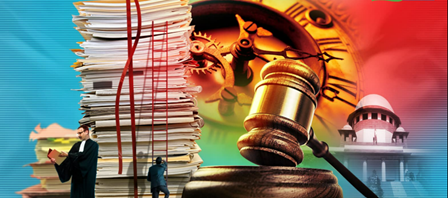
Disclaimer: Copyright infringement not intended.
Context
- A bench of Chief Justice D Y Chandrachud and Justice P S Narasimha refused to entertain a PIL filed by advocate Ashwini Kumar Upadhyay for doubling the number of judges, saying he has adopted a very simplistic approach.
Overview
- As of May 2022, over 4.7 crore cases are pending in courts across different levels of the judiciary. Of them, 87.4% are pending in subordinate courts, 12.4% in High Courts, while nearly 1,82,000 cases have been pending for over 30 years.
- Amid the rising trend of litigation, more people and organisations are approaching courts. This spike, however, is not reflected in the number of judges available to hear these cases. Inadequate infrastructure has resulted in overburdened courts, which in turn has led to a massive backlog of cases.
- Article 51 of Indian Constitution ensures the free legal aid to those citizens who are incompetent to afford a lawyer. The legal aid mandates the 80% of the Indian population is eligible to avail free legal services. But, according to a report out of 1.25 billion population only 15 million have been able to avail its benefit..So the rest of the population who are untouched with their basic legal right.
Pendency and Vacancies in the Judiciary: Vital Stats
Pendency of cases rising across courts; over four and a half crore cases pending at present
- Between 2010 and 2020, pendency across all courts grew by 2.8% annually. As of September 15, 2021, over 4.5 crore cases were pending across all courts in India. Of these, 87.6% cases were pending in subordinate courts and 12.3% in High Courts.
- This implies that, if no new cases were to be filed, the time taken by courts to dispose of all the pending cases at the current disposal rate would be 1.3 years for the Supreme Court and three years each for High Courts and subordinate courts.
- Between 2019 and 2020, pending cases increased by 20% in High Courts and 13% in subordinate courts. Note that in 2020, normal functioning of courts was restricted due to the COVID-19 pandemic. Therefore, while new cases in 2020 were much less than in preceding years, pendency increased because disposal rate was even slower than the rate of new cases filed.
- The pendency of cases in Supreme Court was 70,572 as of May 2, 2022, according to the Supreme Court site.
- Of the 5.9 million (59 lakh) cases pending in the 25 High Courts of India, 42 lakh are civil cases while around 72,000 cases are more than 30 years old.
- Subordinate courts, comprising district and lower courts, have a record backlog of 4,15,12,098 (4.15 crore) cases at present. This includes 3.06 crore criminal cases and 1.08 crore civil cases, the Department of Justice data shows. Over 1.1 lakh cases have been pending for more than 30 years in district and lower courts.
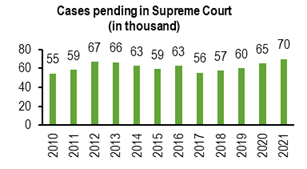
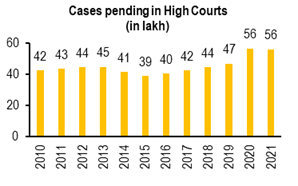
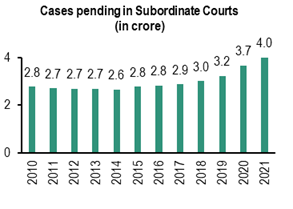
Vacancies in the judiciary also contribute to high pendency of cases
- There is a shortage of judges to decide cases. As of 2021, the Supreme Court had one vacancy out of the sanctioned strength of 34 judges. In the High Courts, 42% of the total sanctioned posts for judges were vacant (465 out of 1,098). Five High Courts (Telangana, Patna, Rajasthan, Odisha, and Delhi) had more than 50% vacancies. High Courts of Meghalaya and Manipur had no vacancies.
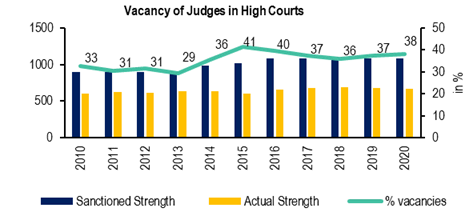
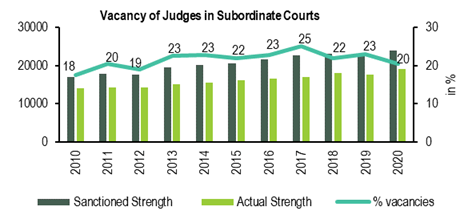
- As of 2020, in subordinate courts, 21% posts out of the sanctioned strength of judges were vacant (5,146 out of 24,018). Amongst states having a sanctioned strength of at least 100 judges, subordinate courts in Bihar had the highest proportion of vacancies at 40% (776), followed by Haryana at 38% (297) and Jharkhand at 32% (219).
Tribunals and special courts also witness significant pendency and vacancies
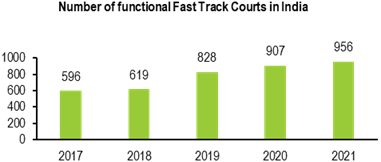
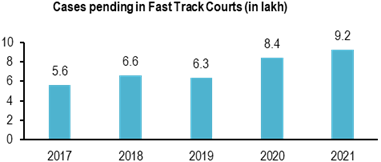
- Tribunals and special courts (such as Fast Track Courts and Family Courts) which were set up to ensure speedy disposal of cases also witness high pendency and vacancies. For instance, at the end of 2020, 21,259 cases were pending before the National Company Law Tribunal (NCLT). As of April 2021, the NCLT had 39 members out of a sanctioned strength of 63.
- In the two decades since Fast Track Courts were first set up, pending cases in both subordinate courts as well as these Fast Track Courts have continued to increase. As on May 31, 2021, over 9.2 lakh cases were pending in 956 Fast Track Courts across 24 states/UTs (the remaining do not have functional Fast Track Courts).
Number of undertrials in prisons more than twice the number of convicts

- Pendency of cases for long periods has resulted in a large number of undertrials (accused persons who are either awaiting or undergoing trial) in India’s prisons.
- As of 2019, almost 4.8 lakh prisoners were confined in Indian jails. Of these, over two-thirds were undertrials (3.3 lakh).
- 5,011 undertrials were confined in jails for five years or longer. Uttar Pradesh (2,142) and Maharashtra (394) accounted for over half of such undertrials.
Recent Stats
- An analysis of data on the National Judicial Data Grid, a database of the Department of Justice, shows that courts saw an increase of over 27% in pendency between December 2019 and April 2022.
- The Ministry of Law and Justice had earlier this year informed the Lok Sabha that 3.7 crore cases – 3.2 crore in subordinate courts and 46.8 lakh in High Courts – were pending in courts till December 2019.
- The latest data from the Department of Justice, reveals that the current cumulative number of 47 million (4.7 crore) pending cases is a result of a massive backlog of 4.15 crore cases in subordinate courts, 59 lakh in High Courts and over 70,000 cases in the Supreme Court.

Undertrials on the rise
- Sharp spike in case pendency in Indian courts has resulted in an increase in the number of undertrials lodged in prisons. An undertrial is a prisoner on trial in a court of law.
- As per the Prison Statistics-2020, released by the National Crime Records Bureau (NCRB),undertrials accounted for 76% of the total inmates in around 1,300 prisons across the country. The NCRB report showed that 3.7 lakh inmates were undergoing trial, while 1.12 lakh were convicted during 2020. In 2019, over two-thirds of a total of 4.8 lakh prisoners were undertrials.
|
Year
|
Number of convicts
|
Number of undertrial prisoners
|
|
2018
|
1,39,656
|
3,24,141
|
|
2019
|
1,44,567
|
3,32,916
|
|
2020
|
1,12,589
|
3,71,848
|
*Source: Prison Statistics India–2020*
State wise Analysis
- With 41,210 such cases, Uttar Pradesh leads the list and is followed by Maharashtra with 23,483, West Bengal with 14,345 and Bihar with 11,713 cases. That’s a total of nearly 91,000 between just these four states. True, they are all large states, but they account for only about 42% of India’s population, so it clearly is not just a function of size. Odisha (4,248) and Gujarat (2,826) are the only other states that have over a thousand cases each pending for over 30 years.
- There are no cases with over three decades of pendency in Chandigarh, Daman and Diu, Dadra and Nagar Haveli, Ladakh, Mizoram, Nagaland and Sikkim. The count is one for Uttarakhand and Puducherry, while it’s less than 10 for Himachal Pradesh and Andaman & Nicobar islands.
- Among large states, Haryana has the lowest number with only 14 such cases. The count is below 100 for Meghalaya, Andhra Pradesh, Delhi, Punjab, Chhattisgarh, Assam, Manipur and J&K. For the remaining states, the number is between 100 and 1,000.
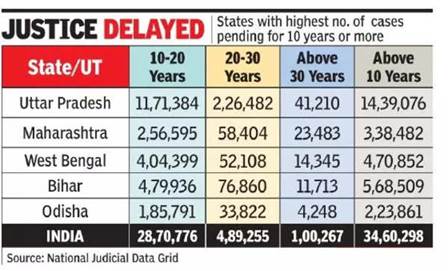
- The analysis shows that in Sikkim more than 99. 6% of pending cases are less than five years old and among larger states, more than 90% of pending cases in Punjab, Haryana, Chhattisgarh, Andhra Pradesh, Uttarakhand and Himachal Pradesh are less than five years old. This proportion is between 80% and 90% for Delhi, Telangana, Assam, MP, Kerala, Karnataka, Tamil Nadu, J&K and Gujarat.
- The share of less than five-year-old cases is between 60% and 70% in UP, Odisha and Bihar and slightly below 60% for West Bengal.
Why do Indian Courts have a huge backlog of cases?
Increase in the awareness of rights by a common man
- Recent socio-economic advances and increased awareness of legal rights have encouraged more people to approach law courts for justice.
New mechanisms (Eg: PIL) and new rights (Eg: RTI)
- Judicial activism is one of the most effective tools for safeguarding citizens' rights. It is very important in implementing social policies on problems such as individual rights, civil rights, public morality, etc. So, PIL has been manifested from judicial activism, and the active judiciary's introduction of new devices like PIL resulted in more cases.
There are not enough judges
- Another prime reason is that there are not enough judges (only around 21,000). The current Judge to Population ratio is 10 to 1 million.
- The Law Commission report in 1987 recommends at least 50 to 1 million. The population has increased by over 25 crores since 1987. What is problematic is that the Centre states that the States must take the lead in increasing the number of judges, and the States say the Center should take the lead. Also, the number of judges is low & the appointed judges are taking long vacations, especially in High Courts.
- There are more than 400 judges’ positions vacant across the 25 high courts, while the lower judiciary has posts of 5,000 judges lying empty. The apex court too has four vacancies. A Department of Justice statement said that as on April 1, 2021, there were also five posts of judges in the apex court that were lying vacant.
There are not enough courts
- Similarly, the Indian judiciary has insufficient resources, due to which there are not enough courts. Indian Judiciary is allotted only with 0.1% to 0.4% of the budget. Hence, modernization and computerization have not embraced all the courts.
There is too much litigation from the Government Side
- The government is the largest litigant in India, responsible for around half the pending cases. Sometimes, one government department sues the other, leaving decision-making to the courts. Also, in most cases, when the government files a case, it is seen that the government side fails to prove the point.
Low judicial quality in lower courts
- The Indian Judiciary has badly failed to attract the best brains and talented students. As the quality of judges in lower courts is not always up to the mark or the judgments are not satisfactory, appeals are filed against the decisions in higher courts, which again increases the number of cases. The peculiar reason of such dissatisfaction is that Judges lack specialization or are lazy.
Vague Drafting of Laws
- The obsolete laws that are part of the statute books, faulty or vague drafting of laws, and their multiple interpretations by several courts are also reasons for prolonged litigation. Some of these laws date back to the 1880s.
Other
- For the existent courts, efficient discharge of its functions depends on a lot of factors such as complexity of facts, type of evidence and materials involved, cooperation of bar i.e. advocates, police, other investigative agencies and most importantly the litigants.
- The lackadaisical working style, lack of efficient mechanisms, manipulative tactics, adjournments for non-substantive reasons, transfer of judges mid-way in a case and a host of other reasons which are due to the stakeholders severely hamper the court’s efficient functioning and leads to pendency of cases which ought to have been disposed much earlier but for the stated reasons.
A Bloomberg Businessweek estimate states, “If the nation’s judges nonstop battled their backlog — with no breaks to eat or sleep — and closed 100 cases per hour, it will take more than 35 years to catch up.”
.jpg)
Way Ahead
Time Bound Trials
- The Concept of Time Frame should be followed, and the Judiciary should prepare a time frame, for the disposal of cases.
The Process should not be a Hurdle
- The court process should not be a hurdle for the people. A vision of equal, expeditious and inexpensive justice for India’s millions, a passion for the effective delivery of social justice for the victims and a mission of constitutional fulfilment through a dynamic rule of law geared to democratic values.
Collegium System and Judges' Appointment
- To maintain transparency, the selection of the High Court judges should be through a transparent and public mechanism so that the right candidate can be chosen to sit in the constitutional courts. No nepotism or favouritism!
-
- Live- Hearings of the PIL
- PIL refers to litigation undertaken to secure public interest and demonstrates the availability of justice to socially disadvantaged parties.
- Individuals with hidden agendas having unscrupulously filed a PIL of dubious nature can only be safeguarded by the live streaming of PIL.
- The Establishment of New Courts
- This is a fact that the non-availability of judges, delays the process of justice courts, so some new courts should be made in District courts for fast disposal of the cases.
- The Massive need for Reforms in Revenue Courts
- Revenue courts are specifically dealing with matters related to land revenue where the sufferers are poor farmers. So, to regulate them, the state should provide these with proper resources and infrastructure so that they can work effectively and efficiently.
-
- The Appointed Senior Advocates
- Advocates who are designated as Senior Advocates should contest at least 20% of the cases pro bono for needy and poor people. A list should be made by State Legal Authority; mentioning the names of advocates and cases should be provided to them.
-
- Modernization of Courts i.e., Virtual Courts
- The Corona period triggered the Indian Judiciary to embrace a more present-day working procedure. The courts are becoming virtual, with cases and hearings occurring over virtual conferences.
- Soon, the courts should be permanently converted into Virtual Mode as it will prove to be very beneficial in decreasing corruption and in saving the expenses caused in Courts. It will be massively helpful to those who are distant. Saves time, effort and money.
Case management
- India is famed for issuing adjournments and encouraging parties to manipulate judicial delays. This can be addressed by modifying legal rules to restrict the number of circumstances that adjournments are granted.
- Modifying the evidence and the procedures of the court and reducing the number of delays, continuations and adjournments permitted by the court can help in management.
- To ensure adherence, the timeline for the completion of the case requires a clear set of penalties, especially for the party deviating from the timeline.
- The data or records of each judge for the disposal of cases should be made public and ideally incorporated in decisions to raise judges to a higher bench.
Faster trial
- The Law Commission has consistently recommended hearing cases, avoiding postponements and arriving at speedy verdicts.
- That is only possible if the case-load per judge is sufficient. It will be a big move forward to create an Indian Judiciary Service and create a wide pool of qualified, committed judges that will increase the pool of talent available for promotion to the higher court.
- Innovative approaches such as developing new courts of appeal, exploring IT technologies that can simplify workflows, constructing improved facilities that enable access to courtrooms are some ways forward to chip away from the current backlog.
Delegating Administrative Functions
- Presently, the respective registries of the courts are mostly tasked with carrying out the judiciary’s administrative functions. This structure has limited the potential for professionalizing these ranks and building up expertise.
- Many other countries have accepted that the administrative functions of courts and tribunals should be supported by a separate professional agencywith administrative expertise, specialization, and modern management practices and technologies.
- For example, in United States, the Administrative Office of the U.S. Courts(a specialized agency established in 1939 within the judicial branch) provides a broad range of legislative, legal, financial, technology, management, administrative, and program support services to federal courts.
- In March 2021, Chief Justice N. V. Ramana has clearly articulated the idea of a National Judicial Infrastructure Corporation, thereby focusing on the judiciary’s administrative functions.
ADR
- The government, being the largest litigant should self-motivate itself to use alternate dispute redressal system and approach the courts only as a matter of last resort.
The 221st Report of the Law Commission
- The 221st report presented by the Law Commission in April 2009 was titled “The Need for Speedy Justice- Some Suggestions.”
- The report was formed taking into account the huge arrears of cases, specifically in High Courts and District Courts.
- It was stated in the report that huge pendency is a cause of great concern not only for the litigants but for the State as well. The report read as “It is a fundamental right of every citizen to get speedy justice and speedy trial which also is the fundamental requirement of good judicial administration.”
The 230th Report of the Law Commission:
- The presentation of the 230th Report of the Law Commission was done in August 2009. The report was titled “Reforms in the judiciary – Some suggestions.” The report suggested that there is a need to bring about radical changes in the formation and functioning of the High Courts in India.
- This will enable the citizens to have fair and speedy justice and will increase their faith in the justice delivery system. The report stressed that under our Constitution, the post of judge holds a significant place. The incumbent mustn’t be just fair, independent, and unbiased but also intelligent and diligent.
- Further, the committee suggested that the strength of judges be increased and new benches of High Courts should be created.
- Moreover, the committee focused on increasing the number of working days and keeping a check on the vacations enjoyed by the Courts.
.jpg)
Conclusion
“Justice delayed is justice denied" is a common aphorism that is often cited while talking about the pendency of cases and jurists note that the achievement of some of the fundamental aims of the Indian Constitution is frustrated by the mounting backlog of cases.
- To start reducing its judicial case backlog, India needs a strategy that focuses on both the immediate problems facing its judiciary and their root causes. The Government should address the institutional weaknesses.
- There is a need of collective effort between legislature, executive and judicial system.
- The spending on research for justice delivery and legal reforms remained low, with only Rs 1.06 spent on it in 2020-2021. We need to spend more on judicial infrastructure.
- A political will and an earnest desire for radical change is a must.
- Right to justice itself being a fundamental right under the Indian Constitution is everyone’s mandate and the State and the courts must do their bit to ensure that a citizen’s tryst with justice meets with justice. It is a larger quest whether a litigant mired in pendency conundrum can ever be rendered complete justice.
Sources:
Court News (2010-2018), Annual Report (2019-20), Supreme Court of India; National Judicial Data Grid for High Courts and Subordinate Courts (last accessed on September 15, 2021); Vacancy Statements (2019-2021), Brief Note on the Scheme of Fast Track Courts (Non-Plan), Department of Justice; Report No. 101, Standing Committee on Personnel, Public Grievances, Law and Justice (2020); Rajya Sabha Unstarred Questions: (i) No. 3458 (March 25, 2021), (ii) No. 1214 (February 11, 2021), (iii) No. 2666 (March 18, 2021); Madras Bar Association vs. Union of India, Supreme Court of India, Writ Petition (Civil) No. 502 of 2021, July 14, 2021; Crime in India (2019, 2020), Prison Statistics India (2019), National Crime Records Bureau; PRS.















.jpg)